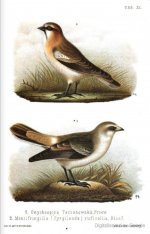l_raty
laurent raty
Trudy St.-Petersb. Obschtsch. Estest (zool)
● Rupicola Bogdanov 1881: 12 (1), p.99
● Sylvicola Bogdanov 1881: 12, p.99
attached.
(NB:
Travaux de la Société impériale des naturalistes de Pétrograd
● Cyanositta Buturlin 1916: 44 (2); p.149
● Actositta Buturlin 1916: 44 (2); pp.151, 156, 168
● Homositta Buturlin 1916: 44 (2); pp.152, 156, 169
● Leptositta Buturlin 1916: 44 (2); pp.153, 156, 169
This is actually the same journal, here listed under its French title, and from a time when St-Petersburg had been renamed Petrograd. (Still later, the Society ceased to be 'Imperial', and Petrograd became Leningrad.) I don't find it online. The full original reference of the paper appears to be:
● Rupicola Bogdanov 1881: 12 (1), p.99
● Sylvicola Bogdanov 1881: 12, p.99
attached.
(NB:
Travaux de la Société impériale des naturalistes de Pétrograd
● Cyanositta Buturlin 1916: 44 (2); p.149
● Actositta Buturlin 1916: 44 (2); pp.151, 156, 168
● Homositta Buturlin 1916: 44 (2); pp.152, 156, 169
● Leptositta Buturlin 1916: 44 (2); pp.153, 156, 169
This is actually the same journal, here listed under its French title, and from a time when St-Petersburg had been renamed Petrograd. (Still later, the Society ceased to be 'Imperial', and Petrograd became Leningrad.) I don't find it online. The full original reference of the paper appears to be:
Бутурлин СА. 1916. Краткий обзор семейства поползней (Sittidae). [A short review of nuthatches (Family Sittidae).] Труды Императорскаго Петроградскаго Общества Естествоиспытателей [Travaux de la Société impériale des naturalistes de Pétrograd], 44: 145-173.
"Actositta" should read Arctositta. In this work are also introduced Poecilositta, Mesositta (the Richmond Index has this name as Melositta, but this seems to be wrong), and Micrositta. As well as, it seems, the subfamily names Cyanosittinae and Daphaenosittinae.)Attachments
Last edited:






